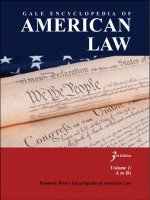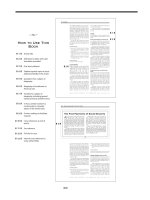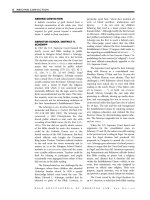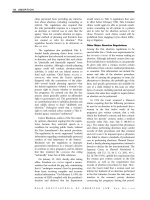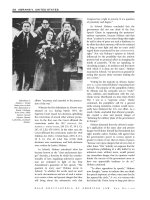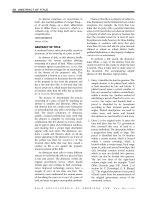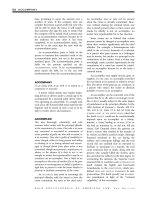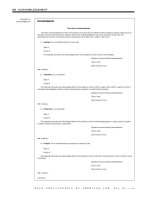Gale Encyclopedia Of American Law 3Rd Edition Volume 1 P23 ppsx
Bạn đang xem bản rút gọn của tài liệu. Xem và tải ngay bản đầy đủ của tài liệu tại đây (310.25 KB, 10 trang )
In fact, beer and wine were staples on the ships
carrying settlers to the New World. In colonial
times, water and milk were scarce and susceptible
to contamination or spoilage, and tea and coffee
were expensive. The Pilgrims turned to such
alternatives as cider and beer, and, less frequently,
whiskey, rum, and gin. In 1790
PER CAPITA
consumption of pure alcohol, or absolute alco-
hol, was just under six gallons per year. (Pure
alcohol constitutes only a small percentage of an
alcoholic drink. For example, if a beverage
contains 10 percent alcohol by volume, one
would have to drink ten gallons of it to consume
one gallon of pure alcohol.)
Although the majority of the colonists drank
alcohol regularly, strong community social stric-
tures curbed any tendency tow a rd immoderation.
Drunken behavior was dealt with by emphasizing
the need to restore community harmony and
stability, rather than by imposing punishment.
Alcohol consumption continued without
much controversy until after the Revolutionary
War when whiskey and other distilled spirits
became valuable commercial commodities.
When Congress imposed an excise tax on the
farmers who produced liquor in the 1790s, they
resisted paying the tax. Their resistance became
known as the Whiskey Rebellion, a
PROTEST
movement of farmers who felt the tax placed an
undue burden on their commercial activities.
Before the nineteenth century, farming was
the predominant occupation, and, although it
involved grueling work, it did not demand
precision or speed. The Industrial Revolution
brought millions of workers into factories
where efficiency, dexterity, and rigid scheduling
were necessary. With these economic changes
came a shift in societal attitudes toward alcohol.
Gone was the time when people considered the
midday liquor break a benign
DIVERSION.
The Temperance Movement
‘Mid pleasures and palaces, though we may
roam,
Be it ever so humble, there’snoplacelike
home.
But there is the father lies drunk on the floor,
The table is empty, the wolf’s at the door,
And mother sobs loud in her broken-back’d
chair,
Her garments in tatters, her soul in despair.
(Nobil Adkisson, Ruined by Drink [c. 1860])
As the United States entered the Industrial Age,
attitudes about alcohol consumption gradually
changed. A moralistic and punitive view of
alcohol replaced the laissez-faire attitudes of
earlier times. What had been the “good creature
of God” in the eighteenth century became the
“demon rum” of the nineteenth.
The U.S. temperance movement emerged
around 1826 with the formation of the Ameri-
can Society for the Promotion of Temperance,
later called the American Temperance Society.
In the 1840s the society began crusading for
complete abstinence from alcohol. Dissemina-
tion of the temperance message caused a fall in
per capita consumption of pure alcohol from a
high of more than seven gallons per year in 1830
to just over three in 1840, the largest ten-year
drop in U.S. history. By the outbreak of the Civil
War, 13 states, beginning with Maine in 1851,
had adopted some form of prohibition as law.
Other temperance organizations became
prominent during the middle to late 1800s. In
1874 the Woman’s Christian Temperance Union
(WCTU) was founded. The only temperance
organization still in operation, the WCTU has
worked continuously since its inception to
educate the public and to influence policies that
discourage the use of alcohol and other drugs. In
ILLUSTRATION BY GGS
CREATIVE RESOURCES.
REPRODUCED BY
PERMISSION OF GALE,
A PART OF CENGAGE
LEARNING.
U.S. Consumer Spending on Alcoholic
Beverages, 1984 to 2007
SOURCE: U.S. Department of Labor, Bureau of Labor
Statistics.
Average amount consumer spent
Year
375
300
225
150
75
0
1984 1988 1992 1996 2000 2004 2007
$275
$269
$301
$309
$372
$459
$457
525
450
GALE ENCYCLOPEDIA OF AMERICAN LAW, 3RD E DITION
208 ALCOHOL
1990 the group was nominated for a Nobel Peace
Prize.
In 1869 the anti-alcohol movement created
its own political party—the National Prohibition
party—devoted to a single goal: to inspire
legislation prohibiting the manufacture, trans-
portation, and sale of alcoholic beverages. The
party made modest showings in state elections
through the 1860s and 1870s and reached its
peak of popular support in 1892 when John
Bidwell won almost 265,000 votes in his bid for
the presidency. The Prohibition party’s main effect
was its influence on
PUBLIC POLICY. I t succeeded in
placing Prohibition planks into many state party
platforms and was a potent impetus behind
passage of the Eighteenth Amendment.
One of the most powe rful forces in the
Prohibition movement was the Anti-Saloon
League, a nonpartisan group founded in 1893 by
representatives of temperance societies and evan-
gelical Protestant churches. The Anti-Saloon
League, unlike t he
PROHIBITION P ARTY,workedwithin
established political parties to support candidates
who were s ympa thetic to theleague’s goals. B y 1916
the league, with the help of the Prohibition party
and the WCTU, had sent en ough sympathetic
candidates to Congress to ensure action on a
Prohibition amendment to the Constitution.
Prohibition
Prohibition is an awful flop.
We like it.
It can’t stop what it’s meant to stop.
We like it.
It’s left a trail of graft and slime.
It don’t prohibit worth a dime.
It’s filled our land with
VICE and crime.
Nevertheless, we’re for it.
(Franklin P. Adams, quoted in Era of Excess)
In December 1917 the temperance movement
achieved its goal when Congress approved the
Eighteenth Amendment, which prohibited the
manufacture, sale, transportation, importation,
or exportation of intoxicating liquors from or to
the United States or its territories. The amend-
ment was sent to the states, and by January 1919
it was ratified. In January 1920 the United States
officially becam e dry.
The demand for liquor did not end with
Prohibition, however. Those willing to violate
the law saw an opportunity to fill that demand
and become wealthy in the process. Illegal stills
produced the alcohol needed to make “bathtub
gin.” Rum and other spirits from abroad were
commonly smuggled into the country from the
east and northwest coasts, and illegal drinking
establishments, known as speakeasies or blind
pigs, proliferated. The illicit production and
distribution of alcohol, called bootlegging,
spawned a multibillion-dollar underworld busi-
ness run by a
SYNDICATE of criminals.
Perhaps the most famous of the bootleggers
was Al Capone, who ran liquor,
PROSTITUTION,
and
RACKETEERING operations in Chicago, one of
the wettest of the wet towns. At the height of his
power in the mid-1920s, Capone made hun-
dreds of millions of dollars per year. He
employed nearly a thousand people and enjoyed
the cooperation of numerous police officers and
other corrupt public officials who were willing
to turn a blind eye in return for a share of his
profits. For years, Capone and other s like him
evaded attempts to shut down their operations.
Capone’s reign finally ended in 1931 when he
was convicted of income
TAX EVASION.
Historians differ about t he success of
Prohibition. Some feel that the effort was a
ludicrous failure that resulted in more severe
social problems than had ever been associated
with alcohol consumption. Others point to
ample evidence that Prohibition, although never
succeeding in making the country completely
dry, dramatically changed U.S. drinking habits.
Per capita consumption at the end of Prohibi-
tion had fallen to just under a gallon of pure
alcohol per year, and accidents and deaths
attributable to alcohol had declined steeply.
Although Prohibition enjoyed widespread
popular support, a substantial minority of U.S.
The 1888 Prohibition
Party presidential
candidate, Clinton
Bowen Fisk, and his
running mate, John
A. Brooks, received
close to 250,000 votes.
Despite the party’s
meager showings in
presidential elections,
it was successful in
influencing public
policy and became an
important player in
the passage of the
Eighteenth
Amendment.
CORBIS.
GALE ENCYCLOPEDIA OF AMERICAN LAW, 3
RD E DITION
ALCOHOL 209
citizens simply ignored the law. Also, although
Prohibition unquestionably fostered unprece-
dented criminal activity, many people were
concerned that the government’s enforcement
efforts unduly intruded into personal privacy.
In cases such as Carroll v. United States, 267 U.S.
132, 45 S. Ct. 280, 69 L. Ed. 543 (1925), the
Supreme Court indicated its willingness to
stretch the limits of
POLICE POWER to enforce
Prohibition. In Carroll, the Court held that
federal agents were justified in conducting a
warrantless search of an automobile, because
they had
PROBABLE CAUSE to believe it contained
illegal liquor.
Concerns over diminished liberties led to
feelings that Prohibition was too oppressive a
measure to impose upon an entire nation. This
sentiment was bolstered by arguments that the
production and sale of alcohol were profitable
enterprises that could help boost the nation’s
depressed economy. By the beginning of the
1930s, after little more than a decade as law,
Prohibition lost its hold on the U.S. conscience.
The promise of jobs and increased tax revenues
helped the anti-Prohibition message recapture
political favor. The
TWENTY-FIRST AMENDMENT,
repealing Prohibition, swept through the neces-
sary 36-state
RATIFICATION process, and the “noble
experiment” ended on December 5, 1933.
Post-Prohibition Regulation and Control
The repeal of Prohibition forced states to
address once more the dangers posed by
excessive alcohol consumption. The risks are
well documented. The National Highway Traf-
fic Safety Administration (NHTSA) estimated
that in 2001 alcohol was involved in 41 percent
of all fatal crashes (more than 17,000 fatalities).
NHTSA also estimates that three out of ten
Americans will be involved in an alcohol-related
crash sometime during their lives. Alcohol is the
most widely used drug among teenagers and is
linked to juvenile crime, health problems,
SUICIDE, date RAPE, and unwanted pregnancy.
Alcohol-related traffic accidents are the leading
cause of death among 15- to 24-year-olds.
In the face of rising concerns about liquor
consumption and
PERSONAL INJURY, many states
chose to regulate alcohol through dramshop
laws. A dramshop is any type of drinking
establishment where liquor is sold for consump-
tion on the premises. Dramshop statutes impose
LIABILITY on sellers of alcoholic beverages for
injuries caused by an intoxicated patron. Under
such statutes, a person injured by a drunk patron
sues the establishment where the patron was
served. The purpose of dramshop laws is to hold
responsible those who enjoy economic benefit
from the sale of liquor, thereby ensuring that a
loss is not borne solely by an innocent victim (as
when the intoxicated person who caused the
injuries has no assets and no insurance).
The first dramshop law, enacted in Wis-
consin in 1849, required saloons or taverns to
post a bond for expenses that might result from
civil lawsuits against their patrons. Many states
followed Wisconsin’s lead, and dramshop laws
were prominent until the 1940s, 1950s, and
1960s, when most were repealed. However, the
1980s brought renewed concern over the
consequences of overindulgence in alcohol,
and public pressure led to the passage of new
dramshop statutes. As of 2009, 42 states as well
as the District of Columbia had imposed some
form of liability on purveyors of alcoholic
beverages for injuries caused by their customers.
All states and the District of Columbia also
regulate the sale of liquor to minors or to
individuals who are intoxicated. Challenges
to the age restriction on
EQUAL PROTECTION
grounds have been unsuccessful.
Along with statutory measures, most courts
have also recognized a common-law
CAUSE OF
ACTION
against alcohol vendors for the negligent
sale of alcohol. In Rappaport v. Nichols, 156 A.2d
1 (N.J. 1959), the court held that a tavern could
be held liable for the plaintiff’shusband’sdeath
after the tavern served an intoxicated minor who
caused the accident that killed the man. The court
relied on the public policy concerns underlying
liquor control laws. Such laws are intended to
protect the general public as well as minors or
intoxicated persons, the court reasoned, and
therefore the tavern should be held liable if its
NEGLIGENCE was a substantial factor in creating the
circumstances that led to the husband’sdeath.
Under Rappaport, serving as well as consuming
alcohol can be construed to be the
PROXIMATE
CAUSE
of an injury. A majority of jurisdictions
later followed the Rappaport court’s reasoning.
In determining the extent of an alcohol
vendor’s liability, a growing number of courts
apply comparative negligence principles. Com-
parative negligence assesses partial liability to a
PLAINTIFF whose failure to exercise reasonable care
contributes to his or her own injury. In Lee v. Kiku
Restaurant, 603 A.2d 503 (N.J. 1992), and Baxter v.
GALE ENCYCLOPEDIA OF AMERICAN LAW, 3RD E DITION
210 ALCOHOL
Noce, 752 P.2d 240 (N.M. 1988), the plaintiffs sued
under dramshop statutes for injuries suffered
when they rode with drunk drivers. The courts in
both cases recognized the importance of dram-
shop statutes in protecting innocent victims of
drunk behavior. However, they also recognized
the need to hold individuals responsible to some
degree for their own safety. Under comparative
negligence, which divides liability among the
parties in accordance with each party’sdegreeof
fault, both goals are achieved.
A few courts have extended liability for injuries
to social hosts who serve a minor or an intoxicated
guest. In Kelly v. Gwinnell, 476 A.2d 1219 (N.J.
1984), the New Jersey Supreme Court found both
the host and the guest jointly liable when the guest
had an accident after drinking at the host’shouse.
The court based the host’s liability on his
continuing to serve alcoholic beverages to the
guest when he knew the guest was intoxicated and
likely to drive a car. Similarly, in Koback v. Crook,
366 N.W.2d 857 (Wis. 1985), the Wisconsin
Supreme Court held that a social host was
negligent for serving liquor to a minor guest at a
graduation party. The guest was later involved in a
motorcycle accident in which the plaintiff was
injured. However, the Ohio Supreme Court
refused to extend liability to the social host in
Settlemyer v. Wilmington Veterans Post No. 49, 464
N.E.2d 521 (Ohio 1984). The court in Settlemyer
held that assigning liability to a social host is a
matter better left to the legislature.
All states and many local governments
regulate the sale of alcohol through the issuance
of licenses. These licenses limit the times and
locations where liquor sales can take place. The
government also regulates alcohol through
TAXA-
TION
. Current taxes on liquor serve the same dual
purpose as did the first excise tax on liquor when
it was proposed by
ALEXANDER HAMILTON in 1791:
They provide a source of revenue for the
government and, theoretically, discourage over-
indulgence. Enforcement of the laws regulating
alcohol and taxing it is carried out by the
BUREAU
OF ALCOHOL
, TOBACCO, FIREARMS, AND EXPLOSIVES
(ATF), an agency of the U.S. JUSTICE DEPARTMENT,
and the Tax and Trade Bureau (TTB), an agency
of the
TREASURY DEPARTMENT, respectively. The
collection of alcohol revenues is important to the
federal government: In 2005, liquor taxes
exceeded $8.9 billion.
Since the 1980s, public awareness of the
dangers of alcohol has led to a number of changes
in the law. Specifically, special interest groups
such as
MOTHERS AGAINST DRUNK DRIVING (MAD D)
and Studen ts Against Drunk Driving (SADD)
urged state legislatures to greatly increase en-
forcement and penalties for driving while
intoxicated (DWI). Criminal statutes make
DWI a
MISDEMEANOR offense. Historically, few
persons served
JAIL time unless they were repeat
offenders. Moreover, prosecutors often reduced
DWI charges to lesser charges, such as reckless
driving, so defendants could avoid the stain of a
DWI
CONVICTION on their driving records.
MADD was formed by mothers of children
who had been kill ed by drunk drivers. They
were outraged at the way the criminal justice
system treated DWI crimes. A major focus in
the 1990s for MADD was convincing state
legislatures to reduce the blood alcohol count
needed to constitute a DWI offense. Specific
blood-alcohol concentration (BAC) limits var-
ied from state to state, but during the 1990s, a
measure of .10 percent BAC usually qualified as
driving while intoxicated.
The debate moved to the national level in
1998 when Congress first rejected and then
enacted legislation that requires all state s to lower
the drunken driving arrest threshold to .08
percent. States that failed to change their laws
would
FORFEIT millions of dollars in federal
highway construction funds. Although states
were initially reluctant to do so, every state since
the end of 2002 has used the .08 percent standard.
An increased knowledge about the conse-
quences of alcohol consumption also had an
effect on the makers of alcohol. Concerned
individuals felt that liquor manufacturers had
the duty to warn consumers that their product
may be hazardous. Before 1987, manufacturers of
alcoholic beverages were immune from civil
liability for injuries resulting from the use of
liquor. Garrison v. Heublein, Inc., 673 F.2d 189
(7th Cir. 1982), held that the
DEFENDANT did not
have a duty to warn the plaintiff of the dangers of
its product. The court stated that the dangers
inherent in the use of alcohol are “common
knowledge to such an extent that the product
cannot objectively be considered to be unreason-
ably dangerous.”
Garrison was followed by other jurisdictions
until 1987 when Hon v. Stroh Brewery, 835 F.2d
510 (3d Cir. 1987), signaled a shift in judicial
sentiment. In Hon, the plaintiff’s 26-year-old
husband died of pancreatitis attributable to his
GALE ENCYCLOPEDIA OF AMERICAN LAW, 3RD E DITION
ALCOHOL 211
moderate consumption of alcohol over a six-year
period. The plaintiff alleged that the defendant’s
products were “unreasonably dangerous” be-
cause consumers were no t warned of the lesser-
known dangers of consumption. The court,
relying on the Restatement (Second) of Torts §
402A, held that a product is defective if it lacks a
warning sufficient to make it safe for its intended
purpose. Because the general public is unaware of
all the health risks associated with liquor
consumption, the court found the defendant
liable for failing to warn the plaintiff.
The reasoning in Hon has been followed in
other cases, including Brune v. Brown-Forman
Corp., 758 S.W.2d 827 (Tex. App. 1988), where
the court found that the defendant’s product
was unreasonably dangerous because it bore
no warning about the dangers of excessive
consumption. The plaintiff’s daughter, a college
student, died after consuming 15 shots of
tequila over a short period of time.
The duty of liquor manufacturers to warn
consumers of the hazards of drinking was
codified when Congress passed the Alcoholic
Drinking on Campus: A Rite of
Passage Out of Control?
A
lcohol has had its advocates and its
critics, particularly on college cam-
puses, where the desires of students to
enjoy the rights and freedoms of adults
collide with the concerns of parents,
university officials, and the police. Al-
though some widely publicized studies
from the late 1980s and early 1990s
indicated that student drinking was at an
all-time high, threatening students’ health
and academic careers, others indicated that
the problem of student drinking was over-
blown and on the decline. By 2009, how-
ever, it was clear that over-consumption
of alcohol, especially in episodes of binge
drinking, remained a national problem. An
Associated Press study found that 157
college-agepeople,age18to23,drank
themselves to death between 1999 and
2005. Attempts to curb drinking on
campus have met with little success, as
enforcement of underage drinking laws has
proved ineffective, if nonexistent. In 2008
the presidentsof100 majoruniversitiesand
colleges threw up their hands andproposed
lowering the drinking age from 21 to 18.
They hoped that this might diminish the
lure of alcohol as a forbidden fruit.
During the 1980s and 1990s atten-
tion focused increasingly on alcohol use
by college students. An article published
in the December 7, 1994, issue of
the Journal of the American Medical
Association reported the findings of a
study conducted by Henry Wechsler,
director of the Alcohol Studies Program
at the Harvard School of Public Health.
Wechsler and his team surveyed more
than 17,000 students, first-year students
to seniors, at 140 colleges in 40 states.
They concluded that college students
were drinking more than ever before.
In Wechsler’s study, 44 percent of
the students surveyed reported binge
drinking, defined as having five consecu-
tive drinks in a row for men or four in a
row for women, on at least one occasion
in the two weeks before the survey.
(Wechsler defined binge drinking at a
lower level of consumption for women
because women’s bodies take longer to
metabolize alcohol, causing them to be
affected by lesser amounts in a given
time period.) Nineteen percent of all the
surveyed students were found to be
frequent binge drinkers, meaning they
had at least three recent binges.
Similar findings were reported in 1994
by the Commission o n Substance Abuse at
Colleges and Universities, a group estab-
lished by the Center on Addiction and
Substance Abuse at Columbia University.
Its report, titled Rethinking Rites of
Passage: Alcohol Abuse on America’sCam-
puses, stated that white males were the
biggest drinkers on campus. However, the
commission noted a sharp rise in the
percentage of college women who drank
to get drunk, from 10 percent in 1977 to 35
percent in 1994. Unlike female students in
earlier studies, those in 1994 reported that
they felt little or no social stigma attached
to their drinking. At the same time, they felt
pressure to succeed, and consuming alco-
hol was one way they
CHOSE to relieve some
of that pressure.
College administrators were not sur-
prised by the findings of the two studies.
The Harvard study reported that an
overwhelming majority of the supervisors
of security, deans of students, and direc-
tors of health services at the colleges
surveyed considered heavy alcohol use a
problem on their campuses. Plus, a survey
by the Carnegie Foundation revealed that
college presidents considered alcohol
abuse their most pressing challenge.
College presidents and administrators
have had practic al reasons t o b e concerned
about student drinking. Reports of drunken
brawls, sexual assaults, even deaths attribut-
able to alcohol create pub lic r elations
nightmares for schools competing for
students. There has also been the issue of
LIABILITY: Is a college responsib le for injuries
inflicted by a drunk student? In addition,
much of the drinking o n campus h as
beendoneillegallybystudentswhoare
under age.
GALE ENCYCLOPEDIA OF AMERICAN LAW, 3RD E DITION
212 ALCOHOL
Beverage Labeling Act of 1988 (27 U.S.C.A.
§ 215). The act requires all alcoholic beverage
containers to bear a clear and conspicuous label
warning of the dangers of alcohol consumption.
The United States’ long history of ambiva-
lence toward the consumption of alcoholic
beverages shows no sign of abating. At the
same time that manufacturers are required to
warn consumers about the health risks inherent
in liquor, some medical studies indicate that
certain health benefits may be associated with
moderate imbibing.
FURTHER READINGS
Alcoholics Anonymous World Services (AAWS). Twelve
Steps and Twelve Traditions. New York: AAWS.
Bartell, Donald J., and Anne D. ImObersteg. 2007. Attacking and
Defending Drunk Dr iving Tests. Santa Anna, Cal.: J ames.
Blocker, Jack S., ed. 1979. Alcohol, Reform and Society.
Westport, Conn.: Greenwood Press.
Boyd, Steven R., ed. 1985. The Whiskey Rebellion. Westport,
Conn.: Greenwood Press.
Cochran, Robert F., Jr. 1994. “‘Good Whiskey,’ Drunk
Driving, and Innocent Bystanders: The Responsibility
of Manufacturers of Alcohol and Other Dangerous
Hedonic Products for Bystander Injury.” South Car-
olina Law Review 45 (winter).
Academic administrators have found
particularly disturbing the increases in
drinking among women. Accordin g to
female stu dents, the de sire to compete with
meninallarenas,includingsocial,isone
reason they feel the need to demonstrate
their equality by drinking as much as or
more than their male peers. A study
conducted b y V irginia’sCollegeofWilliam
and Mary indicated that the number of
women at the college who had five or more
drinks at one sitting increased from 27
percent t o 36 percent during the early 1990s.
Both men and women students have
cited intense peer pressure to join the
partying that takes place on college
campuses, which may begin as early as
Wednesday or Thursday night and last
through the weekend. At some schools,
alcohol-centered gatherings can readily
be found any night of the week. Admin-
istrators acknowledge that partying may
have been just as hearty in the past but
note that before the late 1980s, it was
generally confined to the weekend.
The fallout from uncontrolled drink-
ing has been felt throughout campus life.
According to the report issued by the
Commission on Substance Abuse at Col-
leges and Universities, 95 percent of violent
crimes and 53 percent of injuries on
campus are alcohol related. In 90 percent
of all campus rapes, the assailant, the
victim, or both had been drinking. Sixty
percent of college women who acquire
sexually transmitted diseases, including
herpes and AIDS, report that they were
drunk at the time they were infected. The
financial costs are high as well. Students
spend $5.5 billion on alcohol each year,
more than they spend on books, coffee, tea,
sodas, and other drinks combined. Al-
though athletes might be expected to take
fewer risks with their health than other
students, the commission concluded that
they were equally affected by alcohol abuse.
The commission also found that stu-
dents who belong to fraternities and
sororities drink three times more than their
non-Greek counterparts, averaging 15
drinks per week. Indeed, f raternity drinking
has been blamed in several disciplinary
actions and at least one death. In July 1994
the national office of Alpha Tau Omega
(ATO) announced it was closing 11 of its
chapters for violating rules against hazing
and alcohol abuse. ATO h ad already closed
its chapter at Wittenberg University, in
Springfield, Ohio, after a newly recruited
pledge was h ospi talized in January 1994 for
alcohol poisoning. Similarly, the national
office of Beta Theta Pi (BTP) announced in
1994 that it would intensify enforcement of
rules against hazing and alcohol use in its
chapters. According to Erv Johnson, direc-
tor of communications for the national
office, BTP was concerned not only about
the legal issues involved but also about the
image of the fraternity and the national
office’s desire toemphasize that theprimary
purpose of going to college is to learn.
Excessive drinking has a direct effect on
academic performance. Students with an A
average generally have 3.6 drinks per week,
C students average 9.5 drinks per week, and
D a nd F students co nsume almost 18 d rinks
per week. According to college officials,
alcohol is implicated in almost half of all
academic problems and is an issue for more
than one-fourth of dropouts.
Excessive drinking has obvious nega-
tive consequences for the students who
engage in it, but it also affects those who do
not partake. During the early 1990s some
students and school officials began to speak
out against the damage and disorder that
binge drinkers cause. Just as nonsmokers
brought awareness of the effects of second-
hand smoke, moderate and nondrinking
students called attention to the results of
“secondhand bingeing.” Likewise, admin-
istrators, who had traditionally tried to
downplay the severity of the problem,
began to acknowledge it and tried several
approaches to controlling it. One method
involved having peer counselors educate
students about the dangers of excessive
drinking and about the effects of their
actions on others. Another program pro-
vided students with recreational options
that did not include alcohol. Some schools
offered houses or sections of dorms
where residents pledged not to drink or
smoke. However, most administrators
stopped short of preaching abstinence,
acknowledging that most students have
begun to drink before they enter college.
Concern over binge drinking on
college campuses continued to rise at the
beginning of the twenty-first century. In
2002 the Task Force on College Drinking
of the National Institute on Alcohol Abuse
and Alcoholism (NIAAA) released a study
indicating that 1,400 college students died
and another 500,000 were injured per year
as a result of alcohol abuse. The study also
found that more than 600,000 college
GALE ENCYCLOPEDIA OF AMERICAN LAW, 3RD E DITION
ALCOHOL 213
Cordes, Renee. 1992. “Alcohol Manufacturer Held Partially
Liable for Student’s Death.” Trial 28 (December).
Goldberg, James M. 1992. “Social Host Liability for Serving
Alcohol.” Trial 28 (March).
Gorski, Terence T. 1989. Understanding the Twelve Steps.
New York: Prentice-Hall/Parkside.
Jacobs, James B. 1989. Drunk Driving: An American
Dilemma. Chicago, Ill.: Univ. of Chicago Press.
Khoury, Clarke E. 1989. “Warning Labels May Be Hazard-
ous to Your Health: Common-Law and Statutory
Responses to Alcoholic Beverage Manufacturers’ Duty
to Warn.” Cornell Law Review 75.
Kyvig, David E., ed. 1985. Law, Alcohol, and Order.
Westport, Conn.: Greenwood Press.
Lender, Mark. 1987. Drinking In America: A History. New
York: Free Press.
Moore, Pamela A. 1993. “Lee v. Kiku Restaurant:
Allocation of Fault betw een an Alcohol Vendor and
aPatron—What Could Happen after Providing ‘One
More for t he Road’?” American Journal of Trial
Advocacy 17: 1.
Smith, Christopher K. “State Compelled Spiritual
Revelation: The First Amendment and Alcoholics
Anonymous as a Condition of Drunk Driving Proba-
tion.” 1992. William and Mary Bill of Rights Journal 1
(fall).
Taylor, Lawrence, and Steve Oberman. 2006. Drunk Driving
Defense. New York: Aspen.
students were assaulted annually by
another student who had been drinking,
and more than 70,000 were victims of
alcohol-associated sexual assaults or date
rapes.
Also in 2002, the Harvard School for
Public Health College Alcohol Study issued
its fourth and final report on college
drinking. It put the number of binge
drinkers on college campuses at 44 per-
cent—the same amount as in the school’s
1994 report. This indicated that almost a
decade of trying to combat binge drinking
by colleges and universities had not
succeeded in driving down the number of
binge drinkers. Indeed, the 2002 survey
found an increase in binge drinking among
several groups, including binge drinkers at
women’s colleges, which rose from 24
percent to 32 percent of the population.
The 2002 College Alcohol S tudy found
the n umber of frequent binge drinkers,
defined as students who binged three or
more times over a two-week period, had
also remained steady at 20 percent. These
frequent binge drinkers accounted for 70
percent o f a ll alcohol consumption on
campus. Drin kin g rates were highest a mong
incoming freshmen, males, members of
fraternities or sororities, and athletes. Stu-
dents who attended two-year institutions,
religious schools, commuter schools, or
predominantly or historically black colleges
and universities drank the least.
In response to the failure to bring
down binge drinking rates, colleges and
universities tried innovative approaches to
tackle the problem. One was the use of
“social norms” advertising, telling students
that drinking on colleges was less prevalent
than they thought, to convince students that
most students do not binge drink, and th at
it is socially acceptable to abstain. Critics
pointed out, however, t hat social n orms
advertising might simply send the wrong
message t o administrators and othe r policy
makers—that drinking on campus was no
big deal.
Other universities tried harsher en-
forcement policies, banning alcohol from
college-run housing, even eliminating so-
rorities and fraternities. Some colleges also
tried to curb alcohol related advertising on
campus, refusing to allow sponsorship of
university activities by beer producers and
asking bars and taverns near campus to
limit promotions to college students.
Several reinstated Friday and Saturday
morning classes as a way to encourage
students not to drink on weekends.
College administrators have h ad mixed
results after tackling the problem. For-
mer Middlebury College president John
McCardell formed t he @Amethyst I nitiative
in 2007 for the sole purpose of starting a
debate on lowering the drinking age. B y
2008, he had recruited 100 college pre-
sidents to agree that a discussion begin
about lowering t he drinking age to 18
in hopes of reducing binge drinking.
(Changing stat e l aws would first require
Congress to repeal a federal highway law
that requires states to maintain the drinking
age at 21 or lose all federal highway
funding.) McCardell believed the current
laws were routinely evaded and that they
discriminated against young people. Orga-
nizations such as Mother Against Drunk
Driving oppose the lowering o f the drinking
age and complain that colleges refuse t o
enforcecampuspoliciesaswellasstatelaw.
Other college presidents disagree with the
lowering o f the drinking age. It is c lea r tha t
the idea of allowing 18-year-olds to drink
legally remains a volatile issue.
FURTHER READINGS
College Drinking: Changing the Culture.
National Institute on Alcohol Abuse and
Alcoholism website: lege
drinkingprevention.gov (accessed Mar.
31, 2010)
Okie, Susan. 2002. “Study Cites Alcohol Link
in Campus Deaths; 1,400 Die Yearly in
Accidents.” Washington Post (April 10).
Russell, Jenna. 2002. “Little Improvement
Seen in College Binge Drinking.” Boston
Globe (March 25).
Sullivan, Michelle. 2002. “Students at Risk
Due to ‘Culture of Drinking.’” Clinical
Psychiatry News (June 1).
CROSS REFERENCES
Alcohol “Alcoholics Anonymous” (Sidebar).
Drinking on Campus: A Rite of
Passage Out of Control?
(Continued)
GALE ENCYCLOPEDIA OF AMERICAN LAW, 3RD E DITION
214 ALCOHOL
Vartabedian, Ralph. 2002. “Some States Resist Lower
Alcohol Limits.” Los Angeles Times (December 30).
Wagenaar, Alexander C., and Traci L. Toomey. 2000 “Alcohol
Policy: Gaps Between Legislative Action and Current
Research.” Contemporary Drug Problems 27 (winter).
CROSS REFERENCES
Alcohol, Tobacco, Firearms, and Explosives, Bureau of;
Automobile Searches; Blue Laws; Organized Crime; Product
Liability.
ALCOHOL, TOBACCO, FIREARMS,
AND EXPLOSIVES, BUREAU OF
For more than 80 years, the Bureau of Alcohol,
Tobacco, and Firearms was an agency of the U.S.
DEPARTMENT OF THE TREASURY. The Homeland
Security Act of 2002, Pub. L. No. 107-296, 116
Stat. 2135, divided the agency into two bureaus:
the Bureau of Alcohol, Tobacco, Firearms, and
Explosives (still referred to as ATF) and the Tax
and Trade Bureau (TT B). Effective January 24 ,
2003, the ATF became part o f the
JUSTICE
DEPARTMENT
, while the TTB remained part of the
TREASURY DEPARTMENT. The move of the ATF to the
Justice Department would allow ATF agents and
inspectors to p artner wit h t raditional law enforce -
ment ag encies, such as t he
FEDERAL BUREAU OF
INVESTIGATIO N
. With this change, the TTB became
responsible for revenue collection and regulation
of legitimate alcohol and tobacco industries.
The ATF itself was established on July 1, 1972,
but it traces its roots to the days of
PROHIBITION.
The legendary Eliot Ness and his Untouchables,
famous U.S. revenue agents remembered for their
dramatic surprise raids on illegal alcohol opera-
tions, were predecessors of twenty-first century
ATF agents. The Untouch ables ear ned their na me
Alcoholics Anonymous
T
B
he courts have long struggled with the problem of
what sanctions to impose on people who violate
the law while under the influence of liquor. Punishing
these offenders fails to address the root cause of the
behaviors, the uncontrolled consumption of alcohol.
Many judges order offenders to undergo alcohol-
dependency treatment or counseling as part of a
sentence or as a condition of probation.
One of the most popular programs for treating
alcoholism is Alcoholics Anonymous (AA). AA was
founded in 1935 by New York stockbroker Bill
Wilson and Ohio surgeon Robert Smith. Wilson and
Smith r ecognized their inability to control their
drinking and were determined to overcome their
problem. They developed the Twelve Steps, on
which AA is based and which have become the
foundation for similar self-help and recovery
programs. AA comprises ninety thousand local
groups in 141 countries. Participation is v oluntary,
and there are no dues or other requirements.
Members attend meetings run by nonprofessionals,
many of whom are recovering alcoholics. The
meetings offer fellowship, support, and education
tothosewithadesiretostopdrinking.
Participants in AA declare that they cannot
control their drinking alone, and invoke a higher
power to help them overcome their dependence
on alcohol. AA’s Twelve Steps require a fundamen-
tal change in personality and outlook. Members
admit their powerlessness over alc ohol to them-
selves, to God, and to their friends and families.
They attempt to make amends for any wrongs
they have committed bec ause of alcohol abuse.
Finally, through prayer, meditation, and daily self-
evaluation, AA members strive f or a r adical
transformation or spiritual awakening, which results
in changed perceptions, thought processes, and
actions. Finally, participants share their experie nces
with others.
Although AA’s Twelve Steps speak of God, a
higher power, and spiritual awakening, AA main-
tains that it is not a religious organization. However,
the group’s religious underpinnings and the tone of
its meetings, which may begin with the Serenity
Prayer and generally end with group reci tation of
the Lord’s Prayer, are objectionable to some. Courts
have split over the issue of whether forced
participation in AA violates the First Amendment
religion clauses.
CROSS REFERENCES
First Amendment; Religion.
GALE ENCYCLOPEDIA OF AMERICAN LAW, 3RD E DITION
ALCOHOL, TOBACCO, FIREARMS, AND EXPLOSIVES, BUREAU OF 215
because of their reputation for high moral
integrity and resistance to corruption.
Before the division of the bureau in 2002, the
ATF had a long and somewhat complex history.
With the passage of the
EIGHTEENTH AMENDMENT,
the manufacture, sale, transportation, importa-
tion, and exportation of “intoxicating liquors”
from or to the United States or its territories
became illegal. This amendment ushered in
Prohibition, an era of
ORGANIZED CRIME and
underworld syndicates that controlled an illicit
liquor business with violence and intimidation.
In an attempt to stanch the flow of
WEAPONS
to these criminals, Congress passed several laws
to regulate the firearms and ammunition indus-
tries. Originally, the Bureau of Prohibition was
responsible for administering these laws. In 1942
the Alcohol Tax Unit (ATU), a forerunner of the
ATF, formally took over the bureau’sjobwhen
the bureau was disbanded following repeal of the
Eighteenth Amendment. In 1952 the ATU added
enforcement of tobacco tax laws to its list of
responsibilities and changed its title to the
Alcohol and Tobacco Tax Division (ATTD) of
the
INTERNAL REVENUE SERVICE (IRS).
During the 1960s Congress recognized the
need to control destructive devices other than
firearms. The Omnibus Crime Control and Safe
Streets Act of 1968 and the Gun Control Act of
1968, 18 U.S.C.A. § 921 et seq., superseded earlier
firearms control laws and placed bombs and
other explosives as well as firearms under the
strict control of the government. The ATTD was
given jurisdiction over the criminal use of
explosives and was renamed the Alcohol, Tobac-
co, and Firearms Division (ATFD) of the IRS.
In 1970 the Organized Crime Control Act, 18
U.S.C.A. 841-848, which included the Explosives
Control Act, 18 U.S.C.A. § 842, provided for close
regulation of the explosives industry and desig-
nated certain arsons and bombings as federal
crimes. With the additional responsibility of
enforcing these new laws, the ATFD redefined
its mission in order to distinguish itself from the
IRS. On July 1, 1972, the ATFD was given full
bureau status within the Treasury Department
and acquired the name, the Bureau of Alcohol,
Tobacco and Firearms.
The ATF and TTB are responsible for enfor-
cing and ensuring
COMPLIANCE with the following
laws:
n
Federal Alcohol Administration Act, 27
U.S.C.A. § 201 et seq. (1935);
n
Internal Revenue Code of 1954, as it relates
to distilled s pirits, tobacco products, and
firearms (26 U.S.C.A. §5001 et seq.);
Three Bureau of ATF
agents display
firearms outside an
ATF office in
Maryland. The ATF
is an agency of the
U.S. Justice
Department.
AP IMAGES
GALE ENCYCLOPEDIA OF AMERICAN LAW, 3RD E DITION
216 ALCOHOL, TOBACCO, FIREARMS, AND EXPLOSIVES, BUREAU OF
n
Gun Control Act of 1968, as amended, 18
App. 26 U.S.C.A. § 5801 et seq.;
n
Title XI of the Organized Crime Control
Act (1 970) (Explosives Control Act) (22
U.S.C. §2778);
n
Portions of the Arms Export Control Act
(1976);
n
Trafficking in Contraband Cigarettes Act
(1978) 18 U.S.C.A. 23 41–2346;
n
Anti-Arson Act of 1982 (amended title XI
of the Organized Crime Control Act), 18
U.S.C.A. §§ 841 note, 844;
n
Armed Career C riminal Act of 1984, 18
App. U.S.C.A. §§ 1201, 1202.
In the area of alcohol and tobacco regulation,
as of 2003, the TTB controls production, labeling,
advertising, and the relationships between pro-
ducers, wholesalers, and retailers. The responsi-
bility was previously under the
PURVIEW of the
ATF. TTB efforts are directed mainly at protect-
ing consumers against products that are impure
or mislabeled or otherwise potentially harmful.
During the 1980s alcohol-related activities of
the ATF focused on the promulgation and
enforcement of labeling regulations. For example,
in March 1994, the Miller Brewing Company
replaced an advertisement for one of its beers in
response to concerns raised by ATF officials. The
advertisement showed the beer’slabel,which
listed the product’salcoholcontent,aviolationof
the Federal Alcohol Administration Act (FAAA),
27 U.S.C.A. § 201 et seq., one of the laws the ATF
enforces. However, the strength of that act was
diluted later by a 1995 Supreme Court decision
declaring the restriction unconstitutional. In
Rubin v. Coors Brewing Co., 514 U.S. 476, 115
S. Ct. 1585, 131 L. Ed. 2d 532 (1995), the Court
held that the subsection of the act that prohibits
brewers from advertising the alcohol content of
their beers was unnecessarily broad and violated
the
FIRST AMENDMENT. The Court stated further
that the government’s legitimate interest in
preventing manufacturers from competing by
increasing the alcohol content of their beers could
be accomplished through less restrictive means,
such as by directly limiting the alcohol content of
beer or by banning the advertisement of alcohol
content of high-alcohol brews.
During the 1980s and 1990s, ATF enforce-
ment duties were increasingly focused on fire-
arms as alcohol and tobacco regulation became
mainly a matter of
TAXATION.Asof1991,an
estimated 270,000 dealers, importers, and
manufacturers of firearms, ammunition, and
explosives were licensed in the United States.
Approximately 140 million to 200 million fire-
arms were in circulation. The ATF must oversee
enforcement of the laws regulating these items.
The ATF functioned with relative anonymity
until February 28, 1993, when it became involved
in an ill-fated raid that tainted its reputation and
called its future into question. Acting on reports
of stockpiled weapons and explosives at the
headquarters of a religious sect, the Branch
Davidians of Waco, Texas, ATF agents executed
a military-style raid of the compound. The agents
proceeded with the raid even after discovering
thattheBranchDavidianshadbeentippedoffby
an informant. In the ensuing gunfight, four ATF
agents were killed and fifteen wounded. The
Davidians refused to surrender, and the agents
refused to back down. The standoff continued
until April 19, when ATF agents again moved to
take the compound by force. The raid turned into
a shoot-out and conflagration in which
85 members of the cult, including 17 children,
perished.
The bureau was widely criticized for its
actions at Waco. A report on the incident issued
by the Treasury Department concluded that the
decision to proceed was wrong and that those in
charge of the operation knew it was a mistake to
proceed with the raid because the element of
surprise was missing. The bureau’s director,
Stephen E. Higgins, retired early from his
position, and two agents, Phillip J. Chojnacki
and Charles D. Sarabyn, were suspended for
their roles in the botched raid. Chojnacki and
Sarabyn appealed their suspensions, and, in
December 1994, they were reinstated with full
back pay and benefits, although they were
demoted. In addition, the incident was removed
from their personnel files.
The incident at Waco aroused the ire of
many U.S. citizens, particularly right-wing
MILITIA groups who saw the raid as an example
of government intrusion upon their right to
keep and be ar arms. The
NATIONAL RIFLE ASSOCIA-
TION
sent out membership solicitation letters in
1995 described ATF agents as “jack-booted
government thugs.” Some believe that an April
1995 bombing of a federal building in Okla-
homa City, which took place exactly two years
after Waco, was planned in retaliation for the
ATF raid on the Branch Davidians.
GALE ENCYCLOPEDIA OF AMERICAN LAW, 3RD E DITION
ALCOHOL, TOBACCO, FIREARMS, AND EXPLOSIVES, BUREAU OF 217

